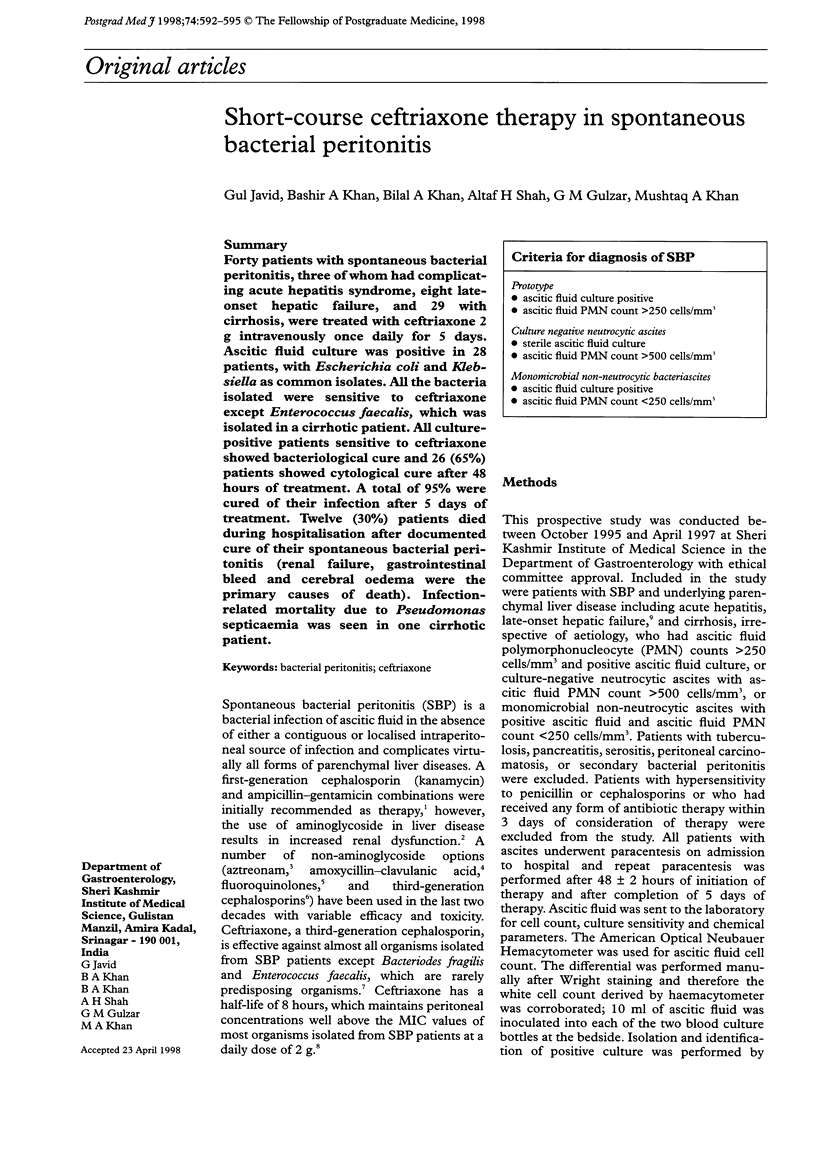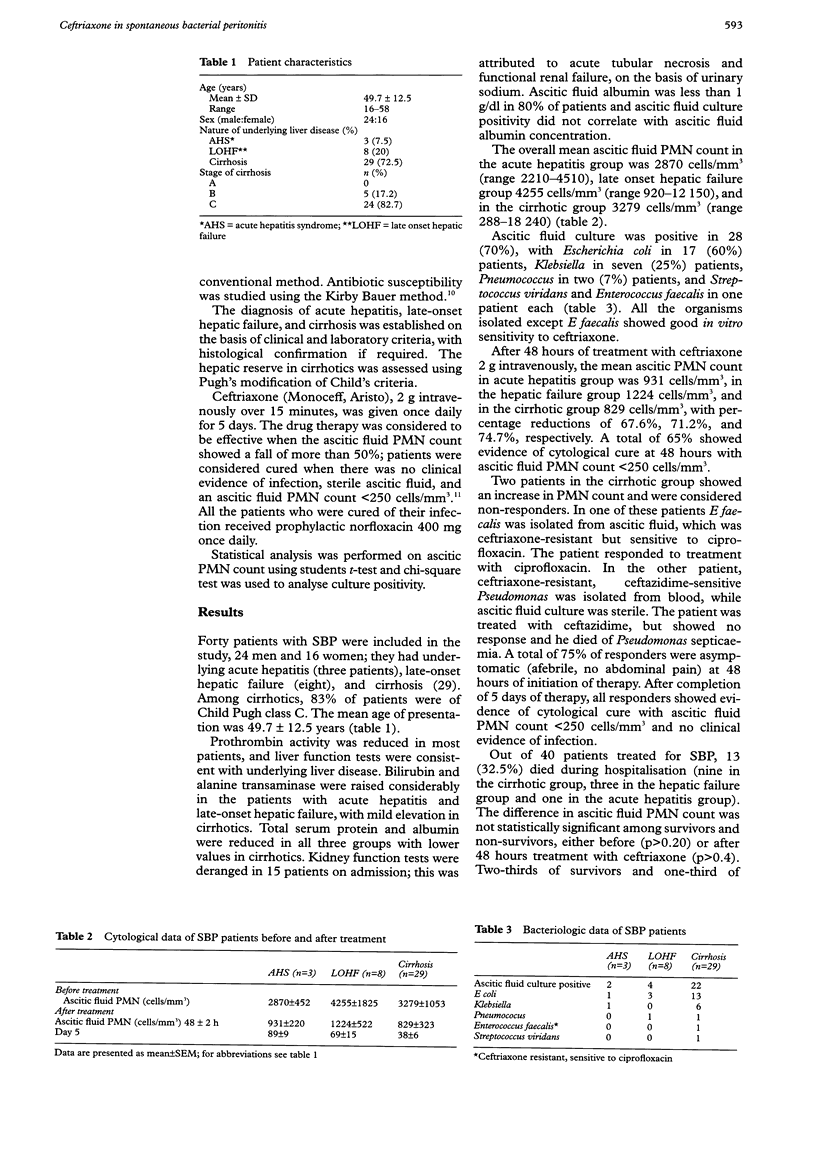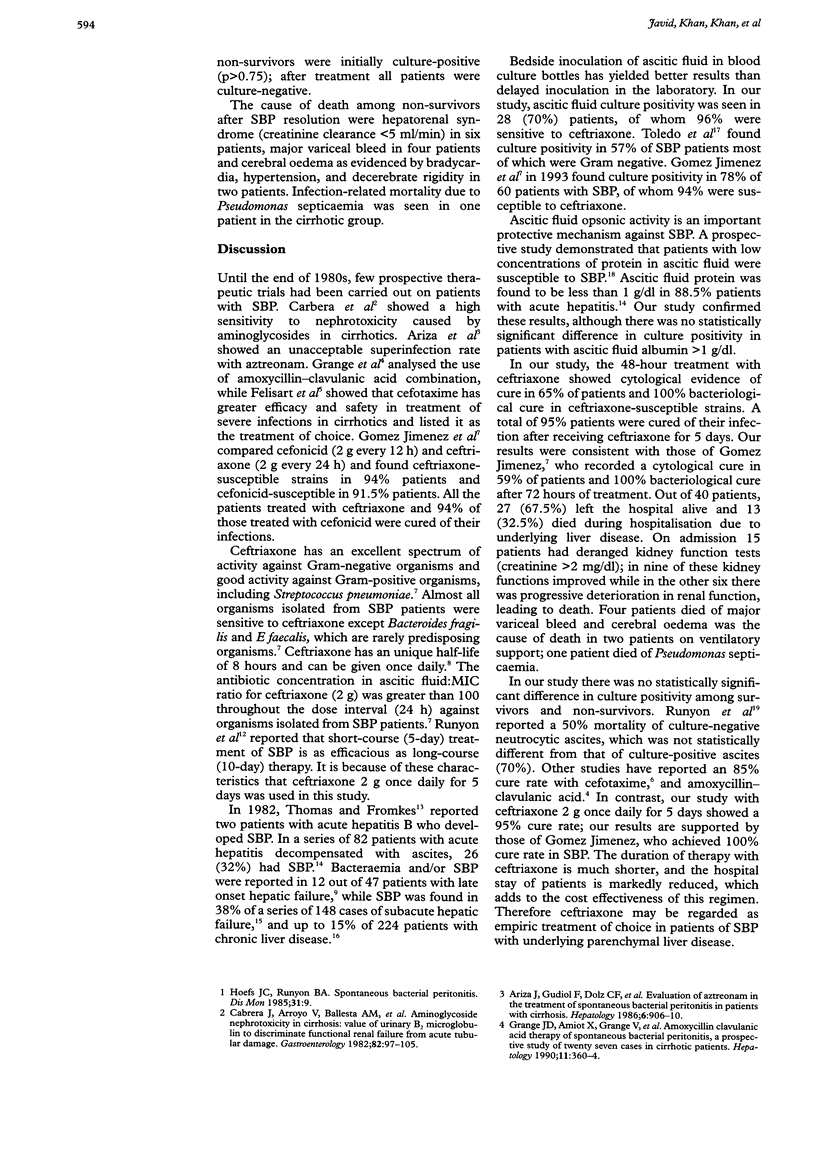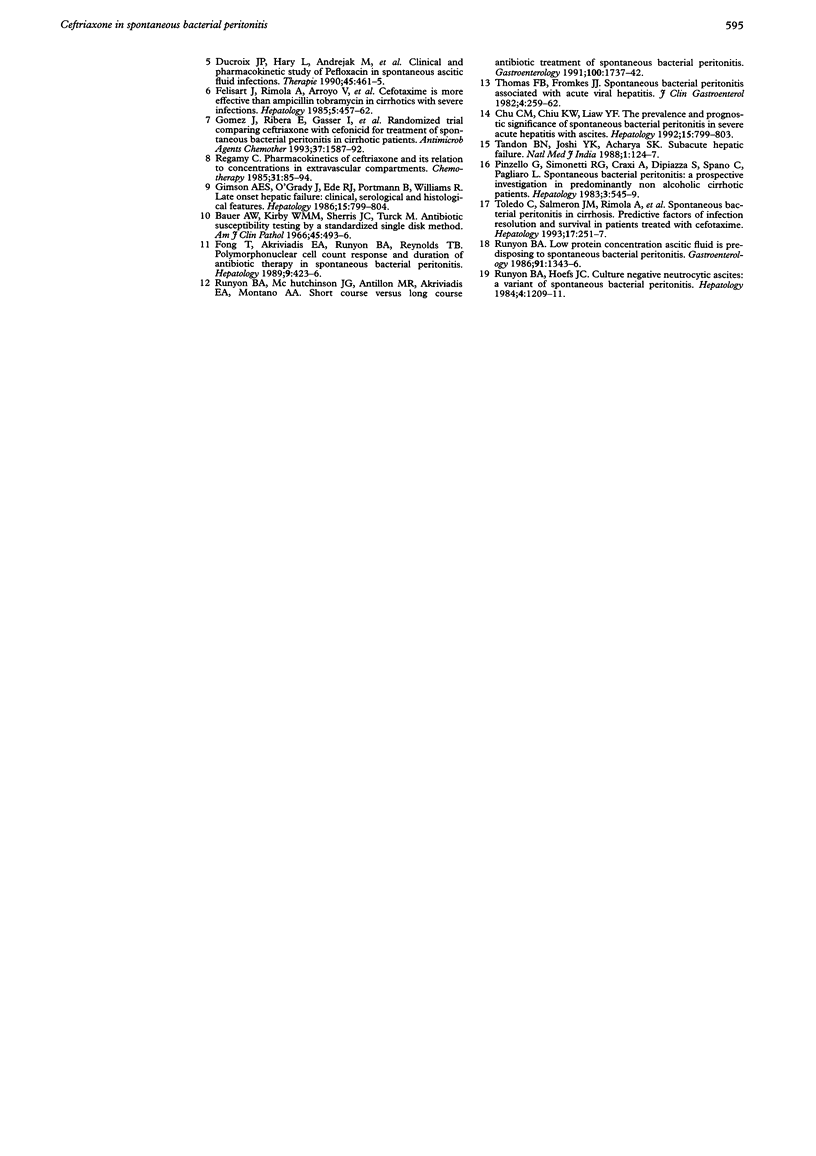Abstract
Forty patients with spontaneous bacterial peritonitis, three of whom had complicating acute hepatitis syndrome, eight late-onset hepatic failure, and 29 with cirrhosis, were treated with ceftriaxone 2 g intravenously once daily for 5 days. Ascitic fluid culture was positive in 28 patients, with Escherichia coli and Klebsiella as common isolates. All the bacteria isolated were sensitive to ceftriaxone except Enterococcus faecalis, which was isolated in a cirrhotic patient. All culture-positive patients sensitive to ceftriaxone showed bacteriological cure and 26 (65%) patients showed cytological cure after 48 hours of treatment. A total of 95% were cured of their infection after 5 days of treatment. Twelve (30%) patients died during hospitalisation after documented cure of their spontaneous bacterial peritonitis (renal failure, gastrointestinal bleed and cerebral oedema were the primary causes of death). Infection-related mortality due to Pseudomonas septicaemia was seen in one cirrhotic patient.
Full text
PDF



Selected References
These references are in PubMed. This may not be the complete list of references from this article.
- Ariza J., Gudiol F., Dolz C., Xiol J., Liñares J., Bosch J., Pallares R. Evaluation of aztreonam in the treatment of spontaneous bacterial peritonitis in patients with cirrhosis. Hepatology. 1986 Sep-Oct;6(5):906–910. doi: 10.1002/hep.1840060516. [DOI] [PubMed] [Google Scholar]
- Bauer A. W., Kirby W. M., Sherris J. C., Turck M. Antibiotic susceptibility testing by a standardized single disk method. Am J Clin Pathol. 1966 Apr;45(4):493–496. [PubMed] [Google Scholar]
- Cabrera J., Arroyo V., Ballesta A. M., Rimola A., Gual J., Elena M., Rodes J. Aminoglycoside nephrotoxicity in cirrhosis. Value of urinary beta 2-microglobulin to discriminate functional renal failure from acute tubular damage. Gastroenterology. 1982 Jan;82(1):97–105. [PubMed] [Google Scholar]
- Chu C. M., Chiu K. W., Liaw Y. F. The prevalence and prognostic significance of spontaneous bacterial peritonitis in severe acute hepatitis with ascites. Hepatology. 1992 May;15(5):799–803. doi: 10.1002/hep.1840150509. [DOI] [PubMed] [Google Scholar]
- Ducroix J. P., Hary L., Andrejak M., Smail A., Tondriaux A., Eb F., Baillet J. Etude clinique et pharmacocinétique de la péfloxacine dans les infections spontanées du liquide d'ascite. Therapie. 1990 Nov-Dec;45(6):461–465. [PubMed] [Google Scholar]
- Felisart J., Rimola A., Arroyo V., Perez-Ayuso R. M., Quintero E., Gines P., Rodes J. Cefotaxime is more effective than is ampicillin-tobramycin in cirrhotics with severe infections. Hepatology. 1985 May-Jun;5(3):457–462. doi: 10.1002/hep.1840050319. [DOI] [PubMed] [Google Scholar]
- Fong T. L., Akriviadis E. A., Runyon B. A., Reynolds T. B. Polymorphonuclear cell count response and duration of antibiotic therapy in spontaneous bacterial peritonitis. Hepatology. 1989 Mar;9(3):423–426. doi: 10.1002/hep.1840090313. [DOI] [PubMed] [Google Scholar]
- Grange J. D., Amiot X., Grange V., Gutmann L., Biour M., Bodin F., Poupon R. Amoxicillin-clavulanic acid therapy of spontaneous bacterial peritonitis: a prospective study of twenty-seven cases in cirrhotic patients. Hepatology. 1990 Mar;11(3):360–364. doi: 10.1002/hep.1840110305. [DOI] [PubMed] [Google Scholar]
- Gómez-Jiménez J., Ribera E., Gasser I., Artaza M. A., Del Valle O., Pahissa A., Martínez-Vázquez J. M. Randomized trial comparing ceftriaxone with cefonicid for treatment of spontaneous bacterial peritonitis in cirrhotic patients. Antimicrob Agents Chemother. 1993 Aug;37(8):1587–1592. doi: 10.1128/aac.37.8.1587. [DOI] [PMC free article] [PubMed] [Google Scholar]
- Pinzello G., Simonetti R. G., Craxì A., Di Piazza S., Spanò C., Pagliaro L. Spontaneous bacterial peritonitis: a prospective investigation in predominantly nonalcoholic cirrhotic patients. Hepatology. 1983 Jul-Aug;3(4):545–549. doi: 10.1002/hep.1840030411. [DOI] [PubMed] [Google Scholar]
- Regamey C. Pharmacokinetics of ceftriaxone and its relation to concentrations in extravascular compartments. Comparison with cefotaxime. Chemotherapy. 1985;31(2):85–94. doi: 10.1159/000238319. [DOI] [PubMed] [Google Scholar]
- Runyon B. A., Hoefs J. C. Culture-negative neutrocytic ascites: a variant of spontaneous bacterial peritonitis. Hepatology. 1984 Nov-Dec;4(6):1209–1211. doi: 10.1002/hep.1840040619. [DOI] [PubMed] [Google Scholar]
- Runyon B. A. Low-protein-concentration ascitic fluid is predisposed to spontaneous bacterial peritonitis. Gastroenterology. 1986 Dec;91(6):1343–1346. doi: 10.1016/0016-5085(86)90185-x. [DOI] [PubMed] [Google Scholar]
- Runyon B. A., McHutchison J. G., Antillon M. R., Akriviadis E. A., Montano A. A. Short-course versus long-course antibiotic treatment of spontaneous bacterial peritonitis. A randomized controlled study of 100 patients. Gastroenterology. 1991 Jun;100(6):1737–1742. doi: 10.1016/0016-5085(91)90677-d. [DOI] [PubMed] [Google Scholar]
- Thomas F. B., Fromkes J. J. Spontaneous bacterial peritonitis associated with acute viral hepatitis. J Clin Gastroenterol. 1982 Jun;4(3):259–262. doi: 10.1097/00004836-198206000-00012. [DOI] [PubMed] [Google Scholar]
- Toledo C., Salmerón J. M., Rimola A., Navasa M., Arroyo V., Llach J., Ginès A., Ginès P., Rodés J. Spontaneous bacterial peritonitis in cirrhosis: predictive factors of infection resolution and survival in patients treated with cefotaxime. Hepatology. 1993 Feb;17(2):251–257. [PubMed] [Google Scholar]


